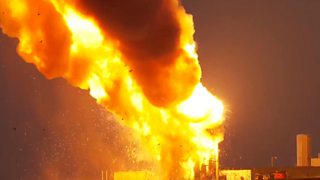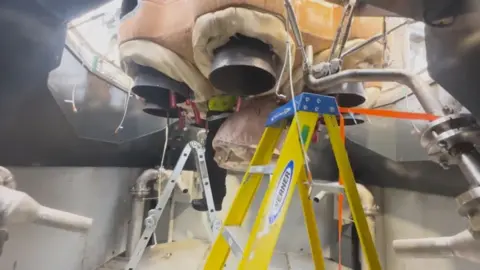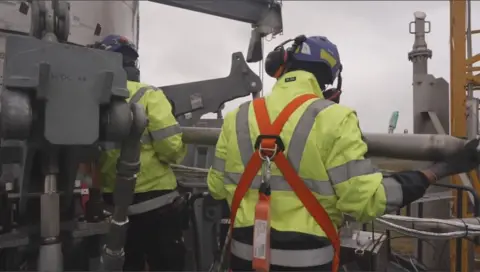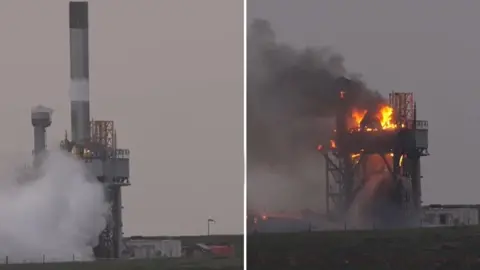SPACE
Rocket engine explodes during launch test in Scotland. #Shetland #Rocket #BBCNews
Rocket engine explodes during test at Scotland spaceport | BBC News
A rocket engine has exploded during a launch test at the UK's new spaceport in Shetland.
The test was being carried out by German company Rocket Factory Augsburg (RFA) who hope to eventually launch the UK's first vertical rocket into orbit.
The scheduled nine-engine test was part of a number of trials due to be carried out before progressing to launch.
RFA said no-one was injured in the explosion and the launch pad had been "saved and is secured".
'Rocket flames began shooting sideways then the sound wave hit'
Lorna Gordon
BBC News Scotland correspondent

Moment rocket engine explodes during launch test in Shetland
We were in Shetland to film the latest developments in the UK's space race when the rocket launch pad caught fire so dramatically.
Our BBC crew was a safe distance across a bay, around a mile away from the rocket's launch pad at SaxaVord spaceport on Unst when the explosion happened on Monday evening.
The 30-second “hot fire test” intended to replicate the downward thrust required to get a rocket into space - without anything actually taking off.
But it was immediately clear the test had not gone according to plan.
Moment rocket engine explodes in Shetland
Rocket engine explodes during test at Shetland spaceport
The team behind the launch is now trying to work out what went wrong with the ground-based engine firing.
Unst is Britain’s most northerly inhabited island. When it comes to the issue of safety around any rocket testing and eventual firing, its remoteness is part of the attraction.
Several rocket companies vying to take satellites into space have already tested engines at their site.
The spaceport has a licence to enable them to carry out up to 30 launches a year.
BBC News had exclusive access to the launch site to witness German rocket company Rocket Factory Augsburg (RFA) prepare for what should have been one of the final milestones before a first test flight planned for the end of the year.
The RFA One is a 30m-tall, three-stage rocket that can deliver a 1,300kg payload to a sun-synchronous orbit around Earth.
RFA wants to use its rockets to launch satellites into orbit, catering to a growing global demand for space launches.
It hopes to be the first company to launch vertical rockets into orbit from UK soil.
SaxaVord Spaceport said all safety protocols were observed and, as is procedure, the site was evacuated prior to Monday's test, leaving no staff at risk.

BBC News filmed preparations on the engine platform before the failed launch test
As evening drew in, heavy showers which had been sweeping across the island briefly eased, making it easier to observe the test from our distant vantage point.
There were signs the test was imminent: frost appearing on the rocket stage, white clouds billowing from beneath the engine.
At any point before ignition the team monitoring the system could abort the test, even with just seconds to go.
All seemed to be going to plan as the test got under way, until flames began shooting sideways from the engine platform, rather than being directed down.
The sound wave hit us a second or two after the engines appeared to ignite.
Sparks flew in all directions as the launch tower was engulfed in flames.
Loud bangs were accompanied by dark, fiery clouds of smoke, twisting upwards as the flames took hold on the platform where we had earlier watched engineers meticulously prepare for this moment.

RFA was trying to ignite nine helix engines simultaneously
Jonas Kellner from RFA had earlier explained to me what the company was hoping to do.
The purpose of the test was, he said, was to ignite all nine helix engines simultaneously, make sure they ran in a stable manner and then shut them off in safe and controlled manner.
Getting all nine engines to fire simultaneously is complicated.
According to Malcolm Macdonald, Professor of Applied Space Technology at the University of Strathclyde, “space is difficult and rockets are even harder”.
He said one of the challenges when firing multiple engines on the same launch vehicle is to get them firing at the same time, working as a pack.
“They’re all vibrating,” he added, “so getting them all to behave correctly and to perform optimally is a real challenge because of the interference of one rocket engine to the next."
Testing and subsequent launches can be fraught with difficulty.
The first UK satellite mission launch was from Cornwall at the beginning of 2023.
It ended when the Virgin Orbit jumbo jet lost the rocket it released horizontally after it suffered an anomaly.
Last year a SpaceX starship spacecraft exploded minutes after lift off.
Afterwards, Elon Musk congratulated his team on what he called an “exciting launch” and said they had learned a lot.

Before and after the launch explosion at the Unst spaceport
The first stage of RFA's 30-metre long rocket test had been impressive.
As we walked around the launch vehicle ahead of what was ultimately an unsuccessful firing, what also stood out to me was the relative youth of this highly skilled workforce of rocket scientists, engineers and technicians.
The average age here is 29. I’m told this is not unusual for companies developing rockets.
The team in Unst and others back at the company's headquarters in Germany will now start studying the pictures from the cameras they had placed around the site and analysing the huge amount of data they have gathered, trying to work out what caused the fire.
In a statement, RFA said they were aware of the higher risk attached to their "iterative approach" and that they will take their time “to assess the situation" and that their goal was to "return to regular operations as soon as possible”.
Setting vertical rockets into space is hard.
The hot fire test in Unst demonstrated both why these tests are important and how challenging launching rockets can be.
BBC News Scotland correspondent

Moment rocket engine explodes during launch test in Shetland
We were in Shetland to film the latest developments in the UK's space race when the rocket launch pad caught fire so dramatically.
Our BBC crew was a safe distance across a bay, around a mile away from the rocket's launch pad at SaxaVord spaceport on Unst when the explosion happened on Monday evening.
The 30-second “hot fire test” intended to replicate the downward thrust required to get a rocket into space - without anything actually taking off.
But it was immediately clear the test had not gone according to plan.
Moment rocket engine explodes in Shetland
Rocket engine explodes during test at Shetland spaceport
The team behind the launch is now trying to work out what went wrong with the ground-based engine firing.
Unst is Britain’s most northerly inhabited island. When it comes to the issue of safety around any rocket testing and eventual firing, its remoteness is part of the attraction.
Several rocket companies vying to take satellites into space have already tested engines at their site.
The spaceport has a licence to enable them to carry out up to 30 launches a year.
BBC News had exclusive access to the launch site to witness German rocket company Rocket Factory Augsburg (RFA) prepare for what should have been one of the final milestones before a first test flight planned for the end of the year.
The RFA One is a 30m-tall, three-stage rocket that can deliver a 1,300kg payload to a sun-synchronous orbit around Earth.
RFA wants to use its rockets to launch satellites into orbit, catering to a growing global demand for space launches.
It hopes to be the first company to launch vertical rockets into orbit from UK soil.
SaxaVord Spaceport said all safety protocols were observed and, as is procedure, the site was evacuated prior to Monday's test, leaving no staff at risk.

BBC News filmed preparations on the engine platform before the failed launch test
As evening drew in, heavy showers which had been sweeping across the island briefly eased, making it easier to observe the test from our distant vantage point.
There were signs the test was imminent: frost appearing on the rocket stage, white clouds billowing from beneath the engine.
At any point before ignition the team monitoring the system could abort the test, even with just seconds to go.
All seemed to be going to plan as the test got under way, until flames began shooting sideways from the engine platform, rather than being directed down.
The sound wave hit us a second or two after the engines appeared to ignite.
Sparks flew in all directions as the launch tower was engulfed in flames.
Loud bangs were accompanied by dark, fiery clouds of smoke, twisting upwards as the flames took hold on the platform where we had earlier watched engineers meticulously prepare for this moment.

RFA was trying to ignite nine helix engines simultaneously
Jonas Kellner from RFA had earlier explained to me what the company was hoping to do.
The purpose of the test was, he said, was to ignite all nine helix engines simultaneously, make sure they ran in a stable manner and then shut them off in safe and controlled manner.
Getting all nine engines to fire simultaneously is complicated.
According to Malcolm Macdonald, Professor of Applied Space Technology at the University of Strathclyde, “space is difficult and rockets are even harder”.
He said one of the challenges when firing multiple engines on the same launch vehicle is to get them firing at the same time, working as a pack.
“They’re all vibrating,” he added, “so getting them all to behave correctly and to perform optimally is a real challenge because of the interference of one rocket engine to the next."
Testing and subsequent launches can be fraught with difficulty.
The first UK satellite mission launch was from Cornwall at the beginning of 2023.
It ended when the Virgin Orbit jumbo jet lost the rocket it released horizontally after it suffered an anomaly.
Last year a SpaceX starship spacecraft exploded minutes after lift off.
Afterwards, Elon Musk congratulated his team on what he called an “exciting launch” and said they had learned a lot.

Before and after the launch explosion at the Unst spaceport
The first stage of RFA's 30-metre long rocket test had been impressive.
As we walked around the launch vehicle ahead of what was ultimately an unsuccessful firing, what also stood out to me was the relative youth of this highly skilled workforce of rocket scientists, engineers and technicians.
The average age here is 29. I’m told this is not unusual for companies developing rockets.
The team in Unst and others back at the company's headquarters in Germany will now start studying the pictures from the cameras they had placed around the site and analysing the huge amount of data they have gathered, trying to work out what caused the fire.
In a statement, RFA said they were aware of the higher risk attached to their "iterative approach" and that they will take their time “to assess the situation" and that their goal was to "return to regular operations as soon as possible”.
Setting vertical rockets into space is hard.
The hot fire test in Unst demonstrated both why these tests are important and how challenging launching rockets can be.
What next for space launch bids after rocket engine explosion in Shetland?
By The Newsroom
Published 20th Aug 2024
Hopes have been dashed that rocket would deliver first orbital satellite launch ever from UK soil later this year
Arocket engine exploded during a test at the SaxaVord Spaceport on Unst, with the fiery conflagration destroying the first stage of the satellite launch vehicle.
German company Rocket Factory Augsburg (RFA) say they are keen to resume operations “as soon as possible” and stress the importance of tests like the one that took place on Monday.
It was hoped this rocket would deliver the first orbital satellite launch ever from UK soil, with plans for it to take place later this year.
Here are some of the key questions about what happens next.
What was it that exploded?
RFA was conducting a “hot fire” of all nine Helix engines on the first stage of the rocket – the lower part of the vehicle which lofts it from the launch pad before separating from the upper stages.
The test took place at the privately-run SaxaVord Spaceport on Unst, the northernmost inhabited island in the UK.
Ultimately, RFA aims to use their rockets to launch satellites into orbit, catering to a growing global demand for space launches.
Called the RFA One, the vehicle is a 30m-tall three-stage rocket, which can deliver a 1,300kg payload to a sun-synchronous orbit around Earth.
What do we know about what went wrong?
Engineers from RFA will be pouring over data and footage from the test to understand what led to the explosion. So far they have not revealed any obvious cause.

He told the PA news agency: “You expect to pass, but you plan for the possibility of failure.
“Failures of these tests, particularly on rockets, are not that uncommon.
“Particularly on new rockets, we see failures relatively frequently on them.”
What will RFA do now?
RFA say their production process is iterative – meaning they incorporate lessons learned from any failures into the next rocket they build.
Earlier this year, its chief commercial officer Jorn Spurmann told the PA news agency they intend to gradually build up their launch cadence to one a month – meaning work on a replacement launcher is already underway.
The most recent timescale for the first launch from SaxaVord was around September or October, but Prof Macdonald said the explosion is likely to put the attempt back by several months and possibly into the new year.
He said: “It might be possible for them to get another first stage up to Shetland relatively quickly.
“But I think integrating all that together, they’ll then want to repeat this test before they move on to a launch attempt.
“So I think it’s unlikely now that we would see an orbital launch within this year.”
Why test and launch on Unst?
With a population of around 600, Unst is the most northerly inhabited part of the UK.
This location is an advantage for certain types of satellites that require a sun-synchronous orbit, as well as the fact any jettisoned debris will not crash down on land.
Owned by husband and wife Frank and Debbie Strang, SaxaVord is a former RAF base developed into a spaceport with around £30 million of investment.
Will this affect other attempts to launch from Scotland?
RFA is not the only company that hopes to achieve an orbital satellite launch from the UK, though its plans are thought to be the most advanced.
Another German company called HyImpulse also has plans to launch from SaxaVord, as well as the US-based ABL Space Systems.
Meanwhile, another company called Orbex hopes to launch from a different spaceport located in Sutherland.
Their efforts will continue.
Virgin Orbital attempted a horizontal launch from the wing of an aircraft which took off from Cornwall in January 2023 but it failed to deliver its payload.
Is this a setback for the space industry in Scotland?
A number of Scottish companies and academic institutions are involved in manufacturing satellites or analysing data gathered from space.
The sector is believed to generate £180 million in income a year, employing more than 8,500 people.
Prof Macdonald said Scotland has a strong space industry, with launch capability being the only missing ingredient so far.
He said: “Obviously things like this get quite high profile and get a lot of interest, but I think most people within the space sector would be expecting setbacks.
“We build the capability over a number of years, and launch is just a small part of the overall space sector.”
Meanwhile, Dr Andy Campbell, founder of the Scottish Space Network, said the explosion is part of a vital learning process.
He said: “It’s easy to focus on the flames and label it a failure. However, what you’re seeing isn’t failure, it’s progress.”
He continued: “The teams have worked tirelessly to reach this point, and while the outcome wasn’t expected, it’s no less valuable.
“It will provide invaluable insights into their systems and procedures, enabling them to learn, adapt and progress.
“I’m confident we’ll soon see a successful orbital launch from UK soil.”
By The Newsroom
Published 20th Aug 2024
Hopes have been dashed that rocket would deliver first orbital satellite launch ever from UK soil later this year
Arocket engine exploded during a test at the SaxaVord Spaceport on Unst, with the fiery conflagration destroying the first stage of the satellite launch vehicle.
German company Rocket Factory Augsburg (RFA) say they are keen to resume operations “as soon as possible” and stress the importance of tests like the one that took place on Monday.
It was hoped this rocket would deliver the first orbital satellite launch ever from UK soil, with plans for it to take place later this year.
Here are some of the key questions about what happens next.
What was it that exploded?
RFA was conducting a “hot fire” of all nine Helix engines on the first stage of the rocket – the lower part of the vehicle which lofts it from the launch pad before separating from the upper stages.
The test took place at the privately-run SaxaVord Spaceport on Unst, the northernmost inhabited island in the UK.
Ultimately, RFA aims to use their rockets to launch satellites into orbit, catering to a growing global demand for space launches.
Called the RFA One, the vehicle is a 30m-tall three-stage rocket, which can deliver a 1,300kg payload to a sun-synchronous orbit around Earth.
What do we know about what went wrong?
Engineers from RFA will be pouring over data and footage from the test to understand what led to the explosion. So far they have not revealed any obvious cause.

The rocket engine explodes during its test launch at the spaceport in Shetland. | BBC
The company is particularly proud of its rocket engines, which use a closed combustion cycle to burn fuel more efficiently than other launchers of the same class.
Professor Malcolm Macdonald of Strathclyde University, an expert in space technology, says the complexity of rocket engine testing increases as more engines are fired up on the same vehicle.
The company is particularly proud of its rocket engines, which use a closed combustion cycle to burn fuel more efficiently than other launchers of the same class.
Professor Malcolm Macdonald of Strathclyde University, an expert in space technology, says the complexity of rocket engine testing increases as more engines are fired up on the same vehicle.
He told the PA news agency: “You expect to pass, but you plan for the possibility of failure.
“Failures of these tests, particularly on rockets, are not that uncommon.
“Particularly on new rockets, we see failures relatively frequently on them.”
What will RFA do now?
RFA say their production process is iterative – meaning they incorporate lessons learned from any failures into the next rocket they build.
Earlier this year, its chief commercial officer Jorn Spurmann told the PA news agency they intend to gradually build up their launch cadence to one a month – meaning work on a replacement launcher is already underway.
The most recent timescale for the first launch from SaxaVord was around September or October, but Prof Macdonald said the explosion is likely to put the attempt back by several months and possibly into the new year.
He said: “It might be possible for them to get another first stage up to Shetland relatively quickly.
“But I think integrating all that together, they’ll then want to repeat this test before they move on to a launch attempt.
“So I think it’s unlikely now that we would see an orbital launch within this year.”
Why test and launch on Unst?
With a population of around 600, Unst is the most northerly inhabited part of the UK.
This location is an advantage for certain types of satellites that require a sun-synchronous orbit, as well as the fact any jettisoned debris will not crash down on land.
Owned by husband and wife Frank and Debbie Strang, SaxaVord is a former RAF base developed into a spaceport with around £30 million of investment.
Will this affect other attempts to launch from Scotland?
RFA is not the only company that hopes to achieve an orbital satellite launch from the UK, though its plans are thought to be the most advanced.
Another German company called HyImpulse also has plans to launch from SaxaVord, as well as the US-based ABL Space Systems.
Meanwhile, another company called Orbex hopes to launch from a different spaceport located in Sutherland.
Their efforts will continue.
Virgin Orbital attempted a horizontal launch from the wing of an aircraft which took off from Cornwall in January 2023 but it failed to deliver its payload.
Is this a setback for the space industry in Scotland?
A number of Scottish companies and academic institutions are involved in manufacturing satellites or analysing data gathered from space.
The sector is believed to generate £180 million in income a year, employing more than 8,500 people.
Prof Macdonald said Scotland has a strong space industry, with launch capability being the only missing ingredient so far.
He said: “Obviously things like this get quite high profile and get a lot of interest, but I think most people within the space sector would be expecting setbacks.
“We build the capability over a number of years, and launch is just a small part of the overall space sector.”
Meanwhile, Dr Andy Campbell, founder of the Scottish Space Network, said the explosion is part of a vital learning process.
He said: “It’s easy to focus on the flames and label it a failure. However, what you’re seeing isn’t failure, it’s progress.”
He continued: “The teams have worked tirelessly to reach this point, and while the outcome wasn’t expected, it’s no less valuable.
“It will provide invaluable insights into their systems and procedures, enabling them to learn, adapt and progress.
“I’m confident we’ll soon see a successful orbital launch from UK soil.”
No comments:
Post a Comment